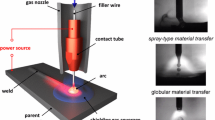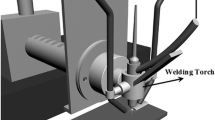Abstract
In arc welding, a groove is often used between metal pieces being welded. In tungsten inert gas welding of high-manganese stainless steels with arc voltage control (AVC), the penetration depth was found to increase with groove wall height. The purpose of this study is to understand the influence of the groove on the penetration depth, mainly through numerical simulation. Spectroscopic measurements were also conducted to validate the simulation. The simulation results showed that when no groove is present, several eddies are formed around the arc column and electrode tip, leading to a recirculating flow pattern. When using a groove, shielding gas introduced from the nozzle flows directly into the arc without forming eddies. In the former case, the metal vapour was transported upwards by the recirculating flow into the arc column and the electrode regions. In contrast, in the latter case, the metal vapour was pushed downward to form a dense metal vapour region over the weld pool and was then swept away horizontally. The arc voltage without a groove is about 1 V lower than that with a groove because the metal vapour around the electrode tip increases the arc electrical conductivity. This affects the arc length control when AVC is used. When the arc voltage increases, the AVC shortens the arc length to keep the voltage constant, leading to the deeper penetration by concentrating the heat input and arc pressure. These mechanisms cause the change of penetration depth when the height of the groove wall is changed.












Similar content being viewed by others
References
Horiuchi T, Ogawa R, Shimada M, Tone S, Yamaga M, Kasamatsu Y (1982) Mechanical properties of high manganese steels at cryogenic temperatures. In: Advances in cryogenic engineering materials. Springer, Boston, MA, 93-103
Tone S, Shimada M, Horiuchi T, Kasamatsu Y, Nakajima H, Shimamoto S (1984) The development of a nitrogen-strengthened high-manganese austenitic stainless steel for a large superconducting magnet. In: Advances in cryogenic engineering materials. Springer, Boston, MA, 145–152
Matsumoto O, Murai Y, Tsuchiyama T, Hada S, Nakajima H (1996) Cryogenic mechanical properties of heavy-section weldment in high-manganese austenitic steel. In: Advances in cryogenic engineering materials. Springer, Boston, MA, 331–337
Sekiguchi N, Yano Y, Kisaka Y, Yoshimura Y, Adachi Y, Yamaguchi T (2019) Manufacturing technologies of superconducting coil conductor for ITER project -Contribution to the promotion for ITER project by overcoming technical problems-. Nippon Steel & Sumikin Engineering Co Ltd. Tech Rev 10:10–19 (Japanese)
Hamada K, Nunoya Y, Isono T, Takahashi Y, Kawano K, Saito T, Oshikiri M, Uno Y, Koizumi N, Nakajima H, Matsuda H, Yano Y, Devred A, Libeyre P, Bessette D, Jewwel MC (2011) Preparation for the ITER central solenoid conductor manufacturing. IEEE Trans Appl Supercond 22:4203404–4203404
Hamada K, Takahashi Y, Suwa T (2019) Mechanical characteristics of conduits for ITER central solenoid conductor. TEION KOGAKU Cryogen Superconduct Soc Jpn 54:437–444 (Japanese)
Nomura K, Yoshii K, Toda K, Mimura K, Hirata Y, Asai S (2017) 3D measurement of temperature and metal vapour concentration in MIG arc plasma using a multidirectional spectroscopic method. J Phys D Appl Phys 50:425205
Ogino Y, Nomura K, Hirata Y (2013) Numerical analysis of arc plasma behaviour in groove welding with 3D TIG arc model. Weld Int 27:867–873
Cai X, Dong B, Lin S, Fan C, Yang C (2020) Numerical analysis of arc physical properties in narrow gap TIG welding. Int J Adv Manuf Technol 106:5509–5517
Murphy AB, Tanaka M, Yamamoto K, Tashiro S, Sato T, Lowke JJ (2009) Modelling of thermal plasmas for arc welding: the role of the shielding gas properties and of metal vapour. J Phys D Appl Phys 42:194006
Murphy AB (2010) The effects of metal vapour in arc welding. J Phys D Appl Phys 43:434001
Tanaka M, Yamamoto K, Tashiro S, Nakata K, Yamamoto E, Yamazaki K, Suzuki K, Murphy AB, Lowke JJ (2010) Time-dependent calculations of weld pool formation and thermal plasma with metal vapour in gas tungsten arc welding. J Phys D Appl Phys 43:434009
Lowke JJ, Tanaka M (2006) ‘LTE-diffusion approximation’ for arc calculations. J Phys D: Appl Phys 39:3634–3643
Boulos MI, Fauchais P, Pfender E (1994) Thermal plasmas fundamentals and applications, vol 1. Plenum Press, New York
Wu D, Tashiro S, Hua X, Tanaka M (2019) Analysis of the energy propagation in the keyhole plasma arc welding using a novel fully coupled plasma arc-keyhole-weld pool model. Int J Heat Mass Transf 141:604–614
Xiang J, Park H, Chen FF, Tanaka K, Shigeta M, Tanaka M, Murphy AB (2020) Numerical study of the effects and transport mechanisms of iron vapour in tungsten inert-gas welding in argon. J Phys D Appl Phys 53:044004
Murphy AB, Tam E (2014) Thermodynamic properties and transport coefficients of arc lamp plasmas: argon, krypton and xenon. J Phys D Appl. Phys 47:295202
Murphy AB, Arundell CJ (1994) Transport coefficients of argon, nitrogen, oxygen, argon-nitrogen and argon-oxygen plasmas. Plasma Chem Plasma Process 14:451–490
Cram LE (1985) Statistical evaluation of radiative power losses from thermal plasmas due to spectral lines. J Phys D Appl Phys 18:401–411
Menart J, Malik S (2002) Net emission coefficients for argon–iron thermal plasmas. J Phys D Appl Phys 35:867–874
Hertel M, Spille-Kohoff A, Fussel U, Schnick M (2013) Numerical simulation of droplet detachment in pulsed gas–metal arc welding including the influence of metal vapour. J Phys D Appl Phys 46:224003
Kisaka Y, Miki S, Sekiguchi N, Kimura F, Tashiro S, Tanaka M, Ozawa S, Suwa T, Takahashi Y (2021) Influence of sulfur content on penetration depth in tig welding for high manganese stainless steels. Metall Mater Trans A 52:5293–5299
Methong T, Yamaguchi T, Shigeta M, Tanaka M, Ikeda R, Matsushita M, Poopat B (2017) Effect of rare earth metal on plasma properties in GMAW using CO2 shielding gas. Welding World 61:1039–1047
Author information
Authors and Affiliations
Corresponding author
Additional information
Publisher's Note
Springer Nature remains neutral with regard to jurisdictional claims in published maps and institutional affiliations.
Rights and permissions
About this article
Cite this article
Tashiro, S., Miki, S., Murphy, A.B. et al. Influence of Groove on Metal Vapour Behavior and Arc Characteristics in TIG Welding of High Manganese Stainless Steels. Plasma Chem Plasma Process 42, 229–245 (2022). https://doi.org/10.1007/s11090-021-10218-y
Received:
Accepted:
Published:
Issue Date:
DOI: https://doi.org/10.1007/s11090-021-10218-y




